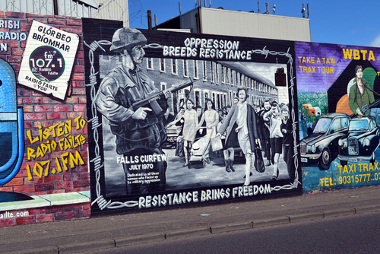THE northern Ireland it is a territory marked by the domination of the United Kingdom and, above all, by the religious division between Catholics and Protestants, which is, above all, political. This split, which goes beyond a mere dispute related to the population's beliefs, has become so fierce that there has been a series of clashes between organized forces on both sides.
Given this configuration, under the justification of maintaining greater security for the different parts, the Northern Ireland Walls, which literally began to divide the population according to their religious beliefs, especially in the city of Belfast, capital of that territory. Although there is no total isolation, the 48% of the Protestant population is separated from the 45% Catholics through the existence of this wall.
As we have said, the division between Catholics and Protestants in Northern Ireland is not just religious, but above all political. Catholics cherish a nationalist ideal, which seeks to unite the local territory with the
Ireland, in a process of unification. Protestants aim to continue integration with the United Kingdom, since the British are predominantly Protestant.The Belfast city wall does not, however, act as a barrier responsible for the total isolation of the population, as there are even “mixed zones” in the central areas of the city. Throughout the day, the movement of people from one place to another is allowed, albeit monitored. At around 7pm, the gates of the wall close and only open again the next day in the morning.
Given this configuration, a context of total separation is formed. Catholics and Protestants do not share many common spaces, including schools, hospitals, recreational spaces, and public and private environments in general. Generations are born and grow up imbued with this sense of aversion from one side to the other, in a separation that goes beyond the marks of geographic space, reaching the symbolic level as well.
The origin of Ireland question is ancient and dates back to the historic English domination over Irish territory, since the 12th century, which became fiercer with the Anglican Reformation and the attempted imposition of it by King Henry VIII. Later, after a two-year series of clashes, England recognized the independence of ¾ of the territory of Ireland in the year 1921, excluding, however, the province of Ulster, better known as Northern Ireland.
In the early 1920s, the WILL (Irish Republican Army), whose objective was to guarantee the total territorial unity of the Eire, the Irish Independent State. For this reason, the IRA committed many attacks considered terrorist, which intensified a scale of conflicts that lasted for several decades in the region, which remains unstable to this day. In 2005, this group laid down its arms and currently acts only on a political level.
The most memorable episode was, without a doubt, the so-called Bloody Sunday, in which a British offensive in the year 1972 killed 13 unarmed civilians who were demonstrating peacefully in favor of the ideal of Irish unification. The episode generated an international milestone that was portrayed in several works of art, books and even songs, such as "Sunday Bloody Sunday", from the band U2. The band The Cranberries also protested against the various deaths and events of the conflict in Ireland with the song “zombie”.
Therefore, many justify the existence of the Belfast Wall and other Irish cities as a way to guarantee the safety of the population on both sides of the conflict. Construction began at the end of the 1960s and has always been the target of much controversy within and outside the country. Currently, some paintings are registered in the construction in the form of murals, many of them as a form of protests against English domination, Irish separatism and also other international causes, such as the Palestine.

Throughout the city of Belfast, paintings like this can be seen along the length of the wall *
Despite being seen as a tourist attraction, the "Peace Lines" - as the Walls of Ireland are also called - should be destroyed by the year 2023, after a Northern Ireland government's plan to end the separation between Catholic and Protestant neighborhoods in order to promote greater socio-cultural integration of the population local.
*Image credits: LunaseeStudios / Shutterstock
By Me. Rodolfo Alves Pena
Source: Brazil School - https://brasilescola.uol.com.br/geografia/muros-irlanda-norte.htm
